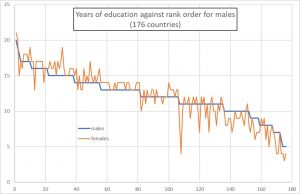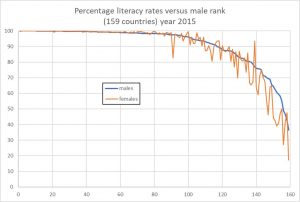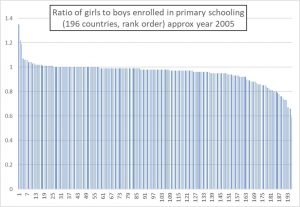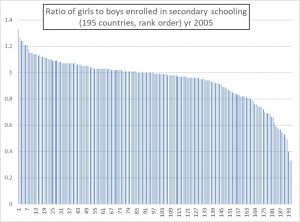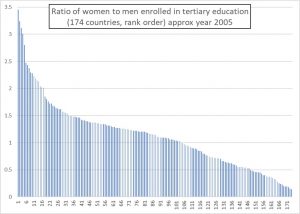Our Foreign Secretary seems to think that the education of boys in other countries is just fine, perhaps because they are being so ably supported by the likes of Boko Haram (click to enlarge)
Contents
1. The Politics
In the current edition of The Spectator (13 Jan 2018) Boris Johnson has an article titled “Girl Power”, subtitled “Educating girls may fix the world’s remaining problems”. Here is an extract,
“Look at those countries where population is growing the fastest, where unemployment is highest, and where the tensions are greatest, and without exception you will find a common factor: female illiteracy.
The correlation is astonishing. Look at the high birth rate countries of sub-Saharan Africa and you will find female illiteracy running at 50, 60, sometimes 70, per cent plus. In Pakistan it is 66% among adult women: 34% even in India. Small wonder that India’s population is set to overtake that of China, where female illiteracy has been all but eliminated.
Yes, it really is that simple. It is not only a moral outrage. It is directly contrary to the interests of world peace, prosperity, health and happiness that such a huge proportion of our population – so many women and girls – should be unable to participate, alongside their brothers, in the economic life of their country. Female education is the universal spanner, the Swiss army knife that helps tackle so many of the problems that Antonio Guterres describes. Societies where women can read, write and do maths as efficiently as their male counterparts will be healthier, happier, more prosperous, with stable populations and therefore with fewer alienated and maladjusted young men whose egos require them to think of women as childbearing chattels.”
He then opines that “the single best and biggest thing we can do for the world is to make sure that every girl gets 12 years of full-time education”.
I will not have to labour my discontent with the above to my regular readership. Unfortunately, I do have to explain my concern to the bulk of the public. There is, obviously, the little matter of the distinction between correlation and causality. However, I’ll pass over that lest I get distracted. I don’t doubt that improving the education of a poorly educated people would result in better outcomes for the society. However, education is not the only factor and further discussion would lead to a very open ended debate about economics, politics and culture.
My concern specifically focusses on the gender issue. My expectation would be that male and female educational attainment across countries would be extremely highly correlated. We will see shortly that the data shows this to be true. Consequently any quantity which is “astonishingly correlated” with female literacy – or female education generally – will therefore automatically be just as strongly correlated with male literacy, or male education generally.
Why, then, does our esteemed Foreign Secretary choose to focus on female education?
Does he imagine that all the world’s 3.5 billion males were educated at Eton and Oxford, as he was himself?
There are a number of possible answers. It may be that he is really targeting Islamic countries. But there is a more generally applicable explanation. No politician – not even Boris with his predilection for gaffs – would be so foolish as to suggest we should focus specifically on male educational attainment. It would be career terminating. Good heavens, no one dares do so even at home where there is a very strong case to be made for such a focus in view of male underachievement. But Boris might merely have referred to ‘education’, free of the gender slant. This would have been innocuous, but would hardly win any plaudits. He’s a politician, and hence concerned with image and popularity above all. To hitch his waggon to specifically female education is to enhance the impact ten-fold. To more firmly establish his gender-sensitive credentials he does what all such men do, he throws other men under a bus to make himself look good. Quite how a focus on educating women would lead to “fewer alienated and maladjusted young men” isn’t clear. And he risks nothing at all in claiming that other men’s “egos require them to think of women as childbearing chattel”.
This is a fine illustration of how identity politics works. Embed an impression in the public that group A is disadvantaged in some way compared with group B. Politicians, and pundits generally, will then gain popularity points by pandering to that narrative. In contrast they would risk censure, and career damage, by any attempt to speak against such a narrative once it is established. Why risk it? So politicians will reinforce such narratives and prejudices. There is no risk in doing so, but great risk in attempting to over-turn the narrative – even when there is clear evidence that it is untrue.
The pre-established narrative in this case is that women and girls are educationally disadvantaged around the world compared with males. This prejudice is so firmly entrenched that even the horrors of Boko Haram cannot displace it in the public mind. When Boko Haram’s activities came to general Western attention in 2014, only the kidnapping of girls caused concern, not the wholesale slaughter of boys – both of whom were equally endeavouring to obtain a decent education. The image which heads this post shows what commonly happened – and is still happening – to boys in Nigeria due to this terrorist group. But the shooting of a single girl, Malala, is promoted above the burning alive, beheading and shooting of thousands of boys. And Michelle Obama did not lose the opportunity to further reinforce the message that it is girls’ education – and only that of girls – which should concern us.
The rest of this post examines whether this prejudice has any basis in fact.
2. Years of Education
I use http://www.nationmaster.com/country-info/stats/Education as my source in this Section (derived ultimately from UN data). The data are from around 2006, so not the latest available – but this source has the data in a convenient format to analyse. That the data is 12 years old will only reinforce the conclusions (since the educational attainment of females has further improved over that time – see, for example, the graph “Gender ratios for mean years of schooling” here). Specifically I use the data from this page, and the corresponding page for females. These give the total years of education by sex for 176 countries. (NB; There are 196 countries in the world, so the coverage is extensive). This includes primary, secondary and tertiary education.
Figure 1 plots the expected years of education for males against rank order (hence a down-going staircase is inevitable). Also shown are the expected years of education for females for the same countries. Since the rank order chosen to define the x-axis is that for males, the data for females will inevitably be scattered, i.e., it will not be monotonically decreasing. However, Figure 1 reveals clearly that the trend for females is the same as that for males.
The (Pearson) correlation between the years of education for males and the years of education for females is 0.93 – which is an extremely strong correlation, as I anticipated. Simply put, if a country has good educational infrastructure then both sexes will have a strong tendency to good educational attainment, whilst if a country has poor educational infrastructure then both sexes will tend to be similarly poorly educated. This is no surprise, but the data confirms that this is the case to quite a high quantitative accuracy.
However, as can be discerned from Figure 1, there is a tendency for women to acquire more years of education in the better developed countries where this exceed 12, but fewer in less well developed countries where this is less than 12. This is manifest in a negative correlation (-0.44) between male educational years and the excess of male over female educational years.
- Of the 176 countries, 43% indicated women had more educational years than men.
- In 70% of countries women had either more educational years than men, or the same number.
- In 30% of countries, men had more educational years than women.
Whilst one might be able to claim a tendency for women in the poorer, less developed, countries being less educated than men, the difference is not marked. The true issue is that neither are well educated. And for well educated women in “the West” to lament the poorer education of women in less developed countries is rather hypocritical given that the gender gap in those countries is of very similar degree, but opposite in sense, to the gender gap in education from which they themselves benefit – an issue which gives them no concern.
Figure 1: Around year 2006 (click to enlarge)
3. Literacy
The literacy data quoted by Boris is for adult women. This is not a forward-looking measure: it includes all those women who would have been of school age some 40, 50, 60 or 70 years ago – when the availability of even basic schooling would have been far, far poorer in underdeveloped countries – and not just for women. It is better to use literacy data specific to ‘young adults’, in the age range 15 to 24 – old enough to have learnt to read and write if they are likely to do so, but young enough to be a current indication. So, for literacy data I have used UN data for year 2015 for the ‘youth’ age range, 15 – 24, from here.
Figure 2 shows the percentage literacy rate for males against rank order (for males), together with the percentage literacy rate for females for the same countries. As with Figure 1, it can be seen that the trend is very similar for both sexes, and for the same obvious reasons. The correlation between male literacy rate and that of females is 0.96, again confirming that Boris Johnson might just as well have observed the “astonishing correlation” of male literacy with “those countries where population is growing the fastest, where unemployment is highest, and where the tensions are greatest”.
Of the 159 countries covered, 23 (14%) have male literacy rates less than 80%, compared with 26 (16%) countries with female literacy rates less than 80%. So, whilst one can pick countries with a more marked gender gap in literacy, overall the gender differences are a small perturbation on the dominant variation between countries.
Figure 2: Year 2015 (click to enlarge)
The number of countries is rather large to list individual data. However, Table 1 gives an indication by broad geographical region or economic group. Sub-Saharan Africa is indeed one of the regions with relatively poor literacy. However, whilst Mr Johnson draws attention to the poor female literacy (average 71.6%) he does not mention that the male literacy is almost as poor (average 78.6%).
Table 1: Literacy Rates (% of Population) by Broad Geographical Region
| Geographical Region or Economic Group | Men | Women |
| Caribbean | 93.4 | 93.5 |
| Caucasus and Central Asia | 99.9 | 99.9 |
| Developed regions | 99.7 | 99.6 |
| Eastern Asia | 99.8 | 99.7 |
| Landlocked developing countries | 78.6 | 73.6 |
| Latin America | 98.3 | 98.7 |
| Latin America and the Caribbean | 98.0 | 98.4 |
| Least developed countries | 78.7 | 74.1 |
| Northern Africa | 95.8 | 93.8 |
| Oceania | 74.6 | 70.5 |
| Small island developing States | 90.1 | 89.4 |
| South-eastern Asia | 98.2 | 98.5 |
| Southern Asia | 89.4 | 84.5 |
| Southern Asia excluding India | 83.2 | 77.9 |
| Sub-Saharan Africa | 78.6 | 71.6 |
| Western Asia | 96.1 | 93.2 |
4. Enrollment Ratios
Figures 3, 4 and 5 show the ratio of females to males enrolling in primary, secondary and tertiary education respectively. The data refer to year 2005, or thereabouts, and were taken from here. Women’s educational fortunes will have improved further in the last 12 years. Note that Figures 1 and 2 include all countries.
For 76% of countries the number of girls enrolling in primary schooling is at least 95% the number of boys enrolling.
For 50% of countries, the number of girls enrolling in secondary schooling is greater than or equal to the number of boys enrolling.
The gender ratio for tertiary education, Figure 5, is rather different from the ratios for school-age pupils, Figures 3 and 4. The latter have a tendency to be close to 1, whereas the former has a broader spread.
60% of countries have more women enrolling in tertiary education than men enrolling. There are 17 countries in which the number of women enrolling in tertiary education is more than double the number of men enrolling.
The dominance of women in tertiary enrollment data reflects the fact that, within any given country, it will tend to be the relatively well-off who go to university. As is seen in all the data, where there is relative wealth – either because the country is wealthy or because of a wealthy demographic within a poorer country – it is women who then tend to be advantaged educationally. Only when a country, or a demographic, is relatively poor – and hence disadvantaged generally – are the educational fortunes of women (even) poorer than those of men.
Figure 3 click to enlarge
Figure 4 click to enlarge
Figure 5 click to enlarge
5. Conclusion
The popular narrative, which is constantly reflected by all politicians and the media, is that women and girls are globally educationally disadvantaged compared with males. This is a gross misrepresentation of reality. Whilst educational fortunes vary widely between nations, the educational attainment of males and females within a given country differ little in comparison with the variation between countries. The relentless emphasis on female education appears to be either identity political expediency or, perhaps, a deliberate policy of social engineering.

